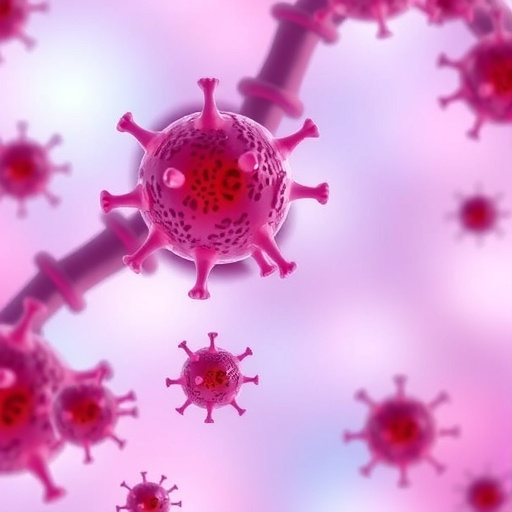In recent years, the landscape of cancer treatment has been dramatically reshaped by the advent of immunotherapy, a strategy that enlists the patient’s own immune system to attack malignant cells. Among the various approaches, neoadjuvant immunotherapy, administered before surgery to shrink tumors and improve surgical outcomes, has shown unprecedented promise. Yet, a crucial challenge remains: predicting which patients will benefit most from such treatments. A groundbreaking study published in BMC Cancer (2025) by Zhang et al. sheds new light on this question by identifying pivotal molecular markers that could forecast treatment response in gastric cancer patients undergoing neoadjuvant immunotherapy.
The study harnessed advanced multiomics methodologies—including RNA sequencing and state-of-the-art proteomics—to delve deeply into molecular changes before and after immunotherapy. By analyzing samples derived from a clinical trial involving 16 gastric cancer patients, the researchers constructed a detailed map of gene and protein expression patterns that differentiate effective treatment responders from non-responders. This approach enabled the identification of CD8A and PGF as critical proteins with predictive value for patient outcomes, offering new avenues for personalized therapy strategies.
One of the study’s central focuses was the role of immune cell populations within the tumor microenvironment. Using the powerful Weighted Gene Co-Expression Network Analysis (WGCNA), the team mapped gene interactions that correlate with therapeutic efficacy. Coupling this with xCell, a computational tool for estimating immune cell proportions from RNA-seq data, the study revealed that patients demonstrating robust responses exhibited increased infiltration of cytotoxic CD8+ T cells and B cells. This enhanced immune presence underscores the essential role adaptive immunity plays in eradicating tumor cells following neoadjuvant immunotherapy.
Stratification based on Tumor Regression Grade (TRG) created two distinct patient cohorts—T1, representing good responders (TRG0 and TRG1), and T2, comprising poor responders (TRG2 and TRG3). Comparative analysis of these groups illuminated stark contrasts in molecular signaling pathways, particularly those involved in inflammatory responses and myeloid leukocyte activation. Notably, the T1 group’s elevated signaling activity suggests that an effective immune system engagement is pivotal for tumor regression, further emphasizing the interaction between immunological factors and therapeutic success.
Among the biomolecules evaluated, CD8A, which encodes the α-chain of the CD8 glycoprotein, emerged as a standout predictive marker. The study calculated an area under the Receiver Operating Characteristic (ROC) curve of 1.000 for CD8A, indicating nearly perfect discrimination between good and poor treatment responses based on its expression. High levels of CD8A correlated strongly with clinical benefit, highlighting the importance of cytotoxic T lymphocyte activity for successful immunotherapy outcomes.
Conversely, the placenta growth factor (PGF)—a protein involved in angiogenesis and inflammatory regulation—displayed a dichotomous role. Its elevated expression was associated with poorer prognosis and reduced treatment efficacy. This suggests that while robust immune activation facilitates tumor control, concurrent pro-angiogenic signaling pathways mediated by PGF may contribute to tumor persistence or resistance, reflecting the complexity of tumor-immune interactions.
Intriguingly, the correlation analyses unveiled a nuanced balance between immune cell types. CD8A expression positively correlated with dendritic cell infiltration—a critical population for antigen presentation and initiation of T cell responses—while exhibiting an inverse relationship with myeloid-derived suppressor cells (MDSCs), known inhibitors of immune activation. This delicate equilibrium offers insight into how immunosuppressive cells may dampen therapeutic effectiveness, and how fostering dendritic cell activity could potentiate anti-tumor immunity.
Methodologically, the integration of RNA-seq data with Olink proteomics allowed for cross-validation at both transcriptomic and proteomic levels, strengthening the reliability of identified biomarkers. Such comprehensive multiomics approaches are instrumental for elucidating complex biological processes, offering an unprecedented resolution into the molecular networks underpinning therapeutic outcomes in cancer.
The clinical implications of these findings are profound. If validated in larger cohorts, monitoring CD8A and PGF protein expression could become an essential part of pre-treatment profiling, enabling oncologists to tailor neoadjuvant immunotherapy regimens more precisely. Patients with high CD8A and low PGF expression profiles might be prioritized for such interventions, whereas alternative or adjunctive therapies could be explored for those with unfavorable signatures.
Beyond predictive utility, the study’s results open potential therapeutic avenues. Targeting PGF-driven pathways could mitigate its adverse effects on immunotherapy response, possibly through combined treatments incorporating angiogenesis inhibitors. Simultaneously, strategies to enhance CD8+ T cell and dendritic cell activity, while suppressing MDSCs, could synergize with existing immunotherapies to improve overall efficacy.
This research adds to a growing narrative underscoring the heterogeneity of tumor immune environments and the necessity for precision medicine in oncology. The journey to harness the full potential of immunoneoadjuvant therapy relies not only on therapeutic innovation but also on deep molecular understanding—something this study exemplifies through meticulous multi-level analysis.
Moreover, the findings underscore the critical importance of the tumor microenvironment’s immunological orchestra, where the interplay between effector cells, suppressive cells, and signaling proteins choreographs treatment outcomes. As such, it calls for future investigative and clinical efforts to focus on manipulating this environment towards favoring immune-mediated tumor eradication.
Future studies should expand upon these insights by including larger patient populations, longitudinal sampling, and integrating additional omics data such as metabolomics and epigenomics. Such efforts would refine biomarker panels and uncover mechanistic underpinnings to overcome resistance, ultimately driving a new generation of tailored and effective gastric cancer therapies.
In conclusion, Zhang and colleagues have illuminated significant molecular determinants of response to neoadjuvant immunotherapy in gastric cancer, with CD8A and PGF standing out as key predictive proteins. This research heralds a new paradigm in which immune profiling and protein expression analysis could revolutionize patient stratification and treatment customization, offering hope for improved survival and quality of life in a challenging disease.
Subject of Research: Predictive molecular biomarkers of response and prognosis in gastric cancer patients undergoing neoadjuvant immunotherapy.
Article Title: Potential predictive value of CD8A and PGF protein expression in gastric cancer patients treated with neoadjuvant immunotherapy.
Article References:
Zhang, C., Wang, T., Yuan, J. et al. Potential predictive value of CD8A and PGF protein expression in gastric cancer patients treated with neoadjuvant immunotherapy. BMC Cancer 25, 674 (2025). https://doi.org/10.1186/s12885-025-14046-7
Image Credits: Scienmag.com




